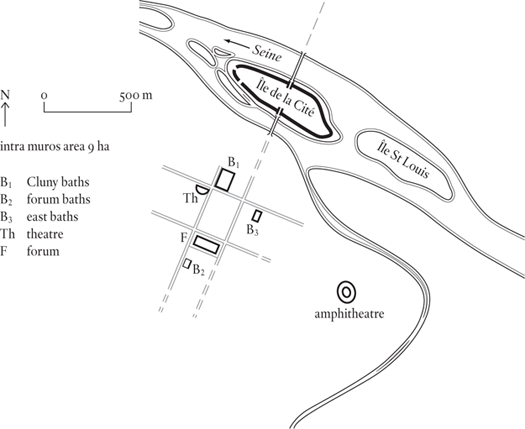
France
Classical Lutetia Parisiorum; county town of the Parisii
Like the other Celtic tribes of Gaul, the Parisii of the Seine valley had an ‘oppidum’, a place where they held their tribal gatherings and which, by the last century BC, may have acquired a small permanent population. Caesar (in De bello Gallico, VII.58) mentions that this meeting place, known as Lutetia, was on an island in the Seine with bridges to either bank, and it is always assumed that the island concerned was the Île de la Cité at the heart of present-day Paris. There is no direct evidence for this, but the island has the right relationship with the town of the same name that the Romans subsequently laid out on the left bank of the river, so it is a reasonable as well as an emotionally satisfying thing to believe. The new town was officially called Lutetia Parisiorum, ‘Lutetia of the Parisii’. In due course it acquired the usual features of Roman urbanism: a forum, a theatre, an amphitheatre and several sets of baths.
In the mid third century AD the good times came to an end as far as the cities of Gaul were concerned. Many of them went up in smoke as barbarian armies roamed through the defenceless territory much as they pleased. What exactly happened to Paris is unknown, but when the fogs of war cleared, the settlement on the left bank was derelict and the population had taken refuge on the Île de la Cité. This was the much-reduced Lutetia of which the emperor Julian spoke so affectionately, praising the climate, the water and the local produce, when he made Paris his headquarters in the winters of AD 358–60.
The Roman town on the left bank of the Seine was never walled, so estimates of its extent (forty to fifty hectares?) and population (3,000 to 4,000?) are matters of choice. The size of the fourth century AD town on the Île can be determined more certainly at nine hectares, indicating that the population at this stage can’t have been more than 1,000 to 1,500. This fits with Lutetia’s lowly position in the administrative hierarchy: the capital of the province in which it was situated, Lugdunensis IV, was SENS, a town of more than twice the size. In fact, Paris owes its place in this book to its later greatness; it never rated very highly in the Roman scheme of things.

Paris fell to the Franks in 486, and Clovis, king of the Franks, made it his residence in 508. But other kings favoured other places – Charlemagne ruled Western Europe from Aachen – and Paris’s position at the top of France’s urban hierarchy was not firmly established before the reign of Philippe Augustus (1180–1223).